An interview with John Picking - oil painter, watercolourist and printmaker
John Picking- Oil painter, Watercolourist and printmaker
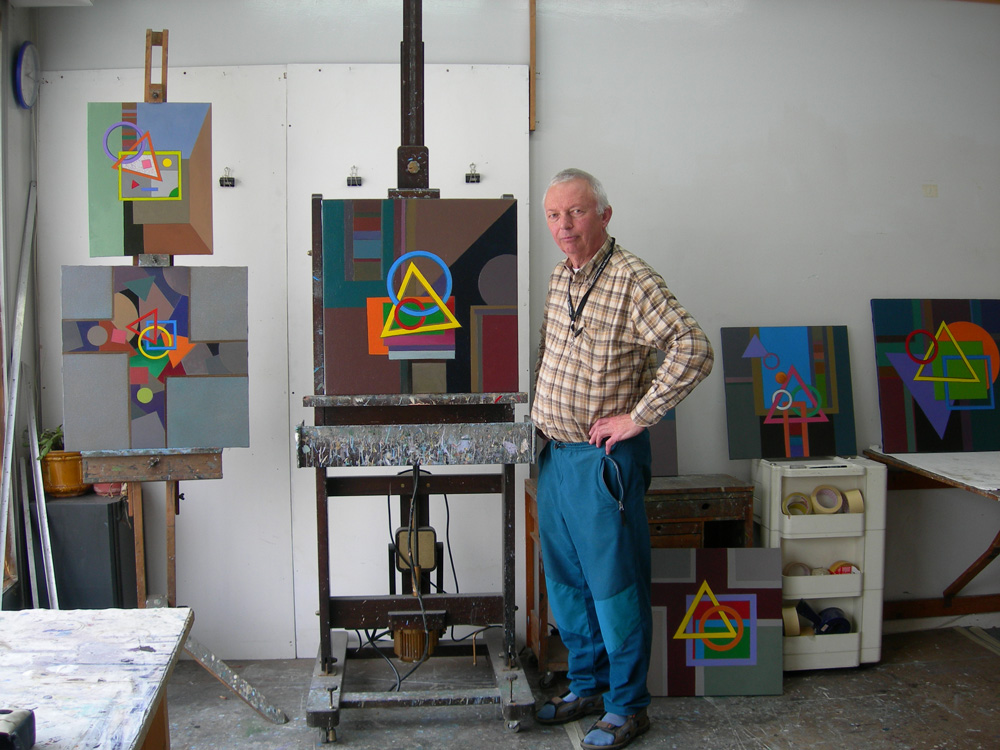 John Picking in his studio in 2010.
Lawrence Art Supplies: Tell us a little bit about your artistic background and education. What inspired you to become an artist?
I did my first oil paintings at fourteen. On Sundays a friend and I would paint the landscape around Wigan. My efforts were terrible, but I was fired with enthusiasm and decided I wanted to study art.
I started at Wigan School of Art when I was sixteen but my drawing was the worst in the group. Anger with myself made me stay every evening for extra classes and after two years I won the Intermediate Course Prize. It was in that period that I first attended etching classes.
After the Diploma in Painting and Lithography, I went into the third year of the Painting School at Edinburgh College of Art. My dad sent me £2 a week and for six months I survived on egg and chips. Eventually I had to tell the Principal that I would have to leave the college, so I returned to my parents in Wigan. Shortly after I returned, I received a letter from Edinburgh College offering me an Andrew Grant bursary to complete my course. I was also given a Post-Diploma grant with my own studio in the college and this led to a further grant, a traveller for a year. I decided to paint in Spain.
Lawrence Art Supplies: Your more recent work predominantly deals with geometric shapes and space, who or what has influenced this particular interest?
John Picking in his studio in 2010.
Lawrence Art Supplies: Tell us a little bit about your artistic background and education. What inspired you to become an artist?
I did my first oil paintings at fourteen. On Sundays a friend and I would paint the landscape around Wigan. My efforts were terrible, but I was fired with enthusiasm and decided I wanted to study art.
I started at Wigan School of Art when I was sixteen but my drawing was the worst in the group. Anger with myself made me stay every evening for extra classes and after two years I won the Intermediate Course Prize. It was in that period that I first attended etching classes.
After the Diploma in Painting and Lithography, I went into the third year of the Painting School at Edinburgh College of Art. My dad sent me £2 a week and for six months I survived on egg and chips. Eventually I had to tell the Principal that I would have to leave the college, so I returned to my parents in Wigan. Shortly after I returned, I received a letter from Edinburgh College offering me an Andrew Grant bursary to complete my course. I was also given a Post-Diploma grant with my own studio in the college and this led to a further grant, a traveller for a year. I decided to paint in Spain.
Lawrence Art Supplies: Your more recent work predominantly deals with geometric shapes and space, who or what has influenced this particular interest?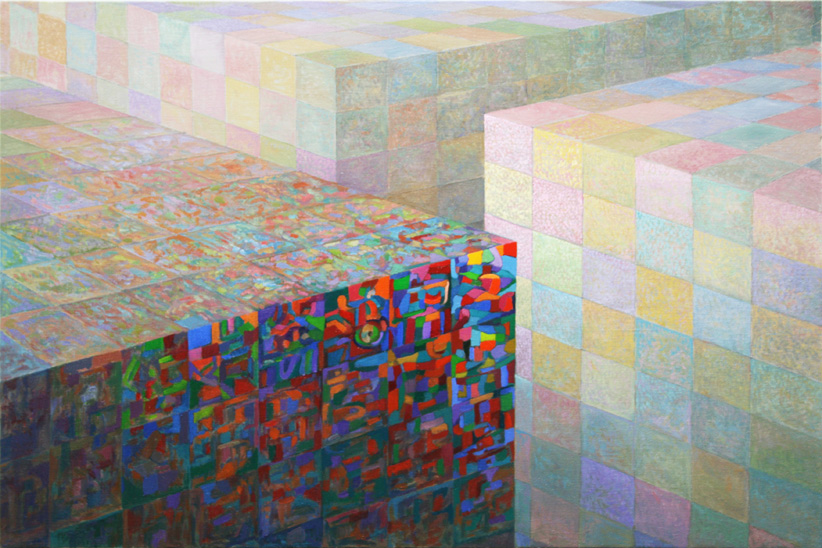 Macro e Micro II- oil painting
Amongst the ruins (from my past) there was a painting, a relief/collage/painting, the kind of thing that I did at Goldsmiths' College many years ago. A friend/collector asked me if that painting existed. I explained that exactly like that, it didn't. He commissioned me to paint it.
The return to a kind of painting I had abandoned years before gave me a strong sense of nostalgia.
In 1969, when I made my first trip to Italy my work had returned to be a kind of metaphysical landscape. Now I jump from one path of my work to the other. Why not? I speak English and Italian. Why can't I paint one minute in one language and the next in another? I could be called eclectic, but I get bored if I risk repeating the same technique all the time.
Macro e Micro II- oil painting
Amongst the ruins (from my past) there was a painting, a relief/collage/painting, the kind of thing that I did at Goldsmiths' College many years ago. A friend/collector asked me if that painting existed. I explained that exactly like that, it didn't. He commissioned me to paint it.
The return to a kind of painting I had abandoned years before gave me a strong sense of nostalgia.
In 1969, when I made my first trip to Italy my work had returned to be a kind of metaphysical landscape. Now I jump from one path of my work to the other. Why not? I speak English and Italian. Why can't I paint one minute in one language and the next in another? I could be called eclectic, but I get bored if I risk repeating the same technique all the time.
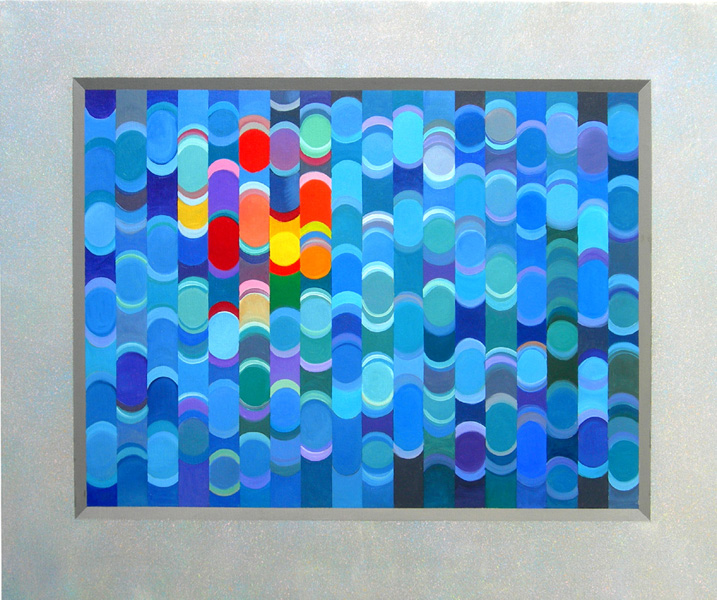 When Picasso was a young man he moved through different periods. But if you notice by the dates on the work, from the late twenties onwards, he did a cubist painting in the morning and a neoclassical drawing in the afternoon.
Lawrence Art Supplies: You also paint figuratively, do the two interests relate to each other?
I have always been very keen on Rennaisance and neo-classical painters. I once read a book called The Hidden Geometry in Art. The best paintings for me have a powerful underlying structure, the thing Cezanne found in Poussin. It's a short step from Cezanne to Braque's first cubist paintings. More than thinking figuratively I think of forms and colours, even when I am doing a portrait.
When Picasso was a young man he moved through different periods. But if you notice by the dates on the work, from the late twenties onwards, he did a cubist painting in the morning and a neoclassical drawing in the afternoon.
Lawrence Art Supplies: You also paint figuratively, do the two interests relate to each other?
I have always been very keen on Rennaisance and neo-classical painters. I once read a book called The Hidden Geometry in Art. The best paintings for me have a powerful underlying structure, the thing Cezanne found in Poussin. It's a short step from Cezanne to Braque's first cubist paintings. More than thinking figuratively I think of forms and colours, even when I am doing a portrait.
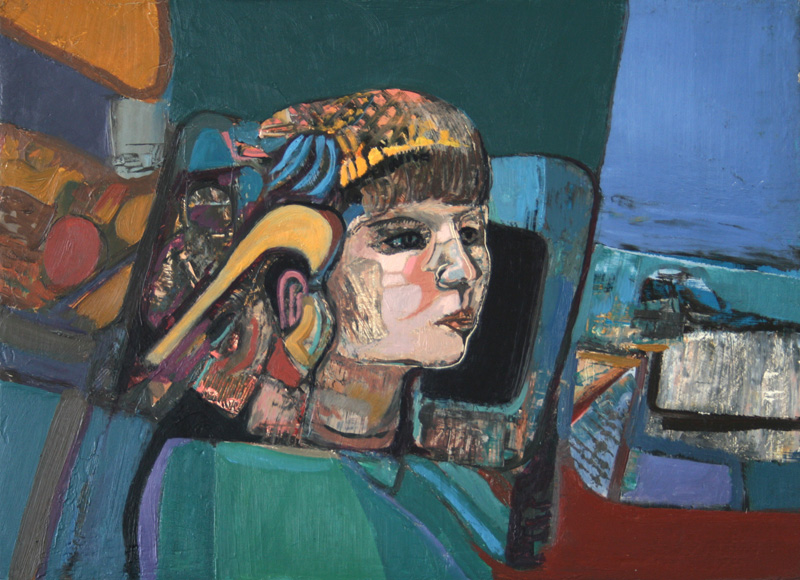 Lawrence Art Supplies: What is the most valuable piece of advice anyone has given you that you still use today?
There are two pieces that come to mind;
The first was at Edinburgh in a composition class. James Cumming, our teacher and well-known Scottish painter, sat down beside me. He mixed a middle tone of grey on my palette. Then he asked me to do two paintings: one where the grey was the darkest tone and the other where it was the lightest. I realised just how relative tone and colour are.
I say to my pupils, imagine a black and white chessboard on a window sill touched in part by a ray of sun. The white squares in the shade can be darker than the black squares in the sun!
The other advice was also whilst I was a student at Edinburgh. They gave me a small traveller to visit London but as I often went there I proposed something different; I was keen on Palmer and Sutherland and decided to investigate their landscape sources, Shoreham in Kent and Pembrokeshire in Wales respectively.
I wrote to Sutherland asking him where precisely he found those motifs. He very kindly invited me to his Trotiscliffe studio saying if I visited him while I was in Kent, he would mark his sources on a map. I took a folio of my drawings and etchings to show him and he encouraged me to follow my personal researches even when my teachers wanted something more academic.
Lawrence Art Supplies: You live in Italy, would you say your environment heavily influences your work?
Yes, it's to do with the light amongst other things. One of my early venues for a few months painting was Cornwall, where I met other painters at St Ives on the same quest. Later I discovered the Mediterranean, first Spain and then Italy. The terraced hillsides first built by the Arabs in Spain and Sicily gave a geometric structure to the landscape which appealed to me.
Lawrence Art Supplies: What is the most valuable piece of advice anyone has given you that you still use today?
There are two pieces that come to mind;
The first was at Edinburgh in a composition class. James Cumming, our teacher and well-known Scottish painter, sat down beside me. He mixed a middle tone of grey on my palette. Then he asked me to do two paintings: one where the grey was the darkest tone and the other where it was the lightest. I realised just how relative tone and colour are.
I say to my pupils, imagine a black and white chessboard on a window sill touched in part by a ray of sun. The white squares in the shade can be darker than the black squares in the sun!
The other advice was also whilst I was a student at Edinburgh. They gave me a small traveller to visit London but as I often went there I proposed something different; I was keen on Palmer and Sutherland and decided to investigate their landscape sources, Shoreham in Kent and Pembrokeshire in Wales respectively.
I wrote to Sutherland asking him where precisely he found those motifs. He very kindly invited me to his Trotiscliffe studio saying if I visited him while I was in Kent, he would mark his sources on a map. I took a folio of my drawings and etchings to show him and he encouraged me to follow my personal researches even when my teachers wanted something more academic.
Lawrence Art Supplies: You live in Italy, would you say your environment heavily influences your work?
Yes, it's to do with the light amongst other things. One of my early venues for a few months painting was Cornwall, where I met other painters at St Ives on the same quest. Later I discovered the Mediterranean, first Spain and then Italy. The terraced hillsides first built by the Arabs in Spain and Sicily gave a geometric structure to the landscape which appealed to me.
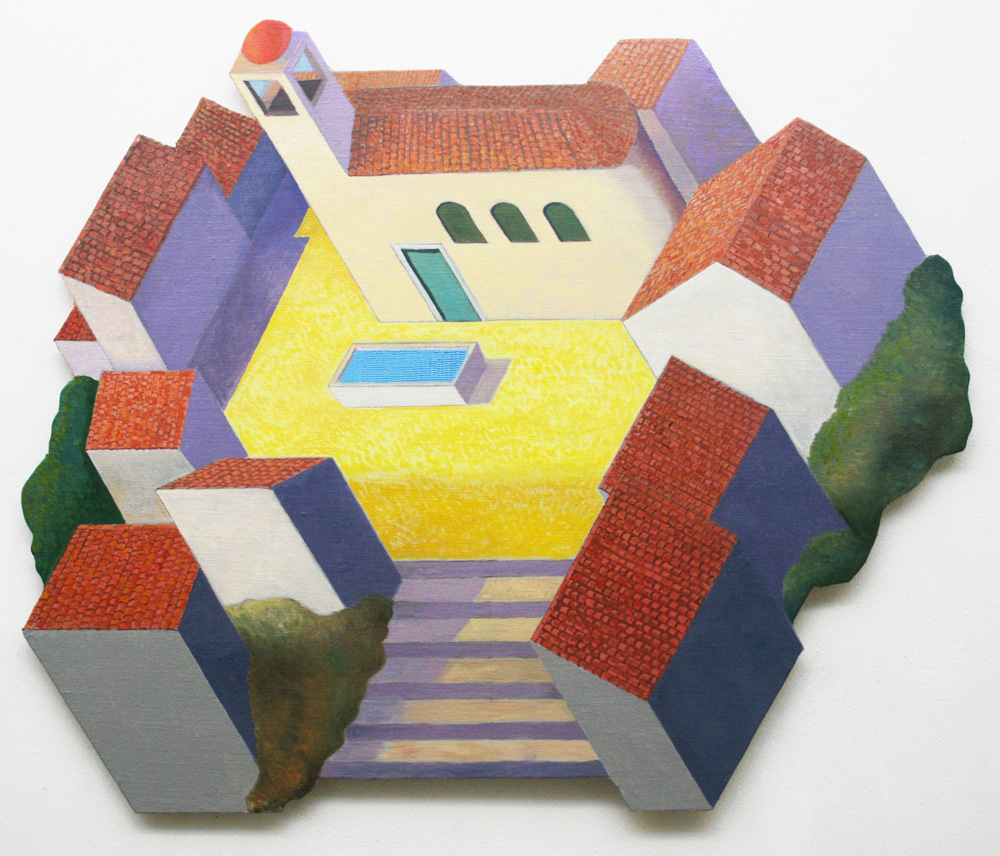 Iso Piazza- oil on panel
At Goldsmiths' our teacher Anton Ehrenzweig proposed a project Organic v. Geometric, dividing the world of forms into two categories. This apposition of the two elements helped me appreciate those classical paintings and the various elements in a landscape. The combination of vines, olives and fig trees, for example, with the terraced landscape, has always been in the background of my work.
Lawrence Art Supplies: How do you approach a blank canvas, do you see in your mind how the finished painting should look?
There never seems to be a blank canvas. Your question brings to mind that film of Mr Bean who strokes his chin before a blank canvas wondering what to paint! Most of my ideas originate from drawings. During the day at the studio I work on a group of oils, in the evening I do scribbles of ideas, studies and watercolours. There is probably a theme running through them.
When I finish a group of oils I take the drawings to the studio, there may be fifty or more. I spread them out on the floor and choose between ten and fifteen and I attach a PostIt label on these allocating a size of canvas.
I often start with acrylics on a coloured ground for the first sitting. I probably start four or five in a day. I like to establish the linear structure of the painting but I can't say what the colour will be like in the end. That's a matter of changing and balancing as I go along. As I develop the works in oils the pace slows down and I may work on one canvas for a whole day or more before moving to the next. Having a group has technical advantages; I can leave time to dry between painting layers by moving on to the next which has been drying for a week or more. After about two months or so, I finish the cycle.
I never wait for inspiration; ideas arrive at odd moments, like when I'm at the supermarket. When I get home I do one of my scribbles.
Lawrence Art Supplies: What does your typical day in the studio entail?
I go to the studio at about 6am and answer e-mails and make notes on the day's work etc. Usually by 7 I'm at work on my canvases. Lately, I have been doing more commissioned art work and less for dealers, this means I may work longer on one thing.
Iso Piazza- oil on panel
At Goldsmiths' our teacher Anton Ehrenzweig proposed a project Organic v. Geometric, dividing the world of forms into two categories. This apposition of the two elements helped me appreciate those classical paintings and the various elements in a landscape. The combination of vines, olives and fig trees, for example, with the terraced landscape, has always been in the background of my work.
Lawrence Art Supplies: How do you approach a blank canvas, do you see in your mind how the finished painting should look?
There never seems to be a blank canvas. Your question brings to mind that film of Mr Bean who strokes his chin before a blank canvas wondering what to paint! Most of my ideas originate from drawings. During the day at the studio I work on a group of oils, in the evening I do scribbles of ideas, studies and watercolours. There is probably a theme running through them.
When I finish a group of oils I take the drawings to the studio, there may be fifty or more. I spread them out on the floor and choose between ten and fifteen and I attach a PostIt label on these allocating a size of canvas.
I often start with acrylics on a coloured ground for the first sitting. I probably start four or five in a day. I like to establish the linear structure of the painting but I can't say what the colour will be like in the end. That's a matter of changing and balancing as I go along. As I develop the works in oils the pace slows down and I may work on one canvas for a whole day or more before moving to the next. Having a group has technical advantages; I can leave time to dry between painting layers by moving on to the next which has been drying for a week or more. After about two months or so, I finish the cycle.
I never wait for inspiration; ideas arrive at odd moments, like when I'm at the supermarket. When I get home I do one of my scribbles.
Lawrence Art Supplies: What does your typical day in the studio entail?
I go to the studio at about 6am and answer e-mails and make notes on the day's work etc. Usually by 7 I'm at work on my canvases. Lately, I have been doing more commissioned art work and less for dealers, this means I may work longer on one thing.
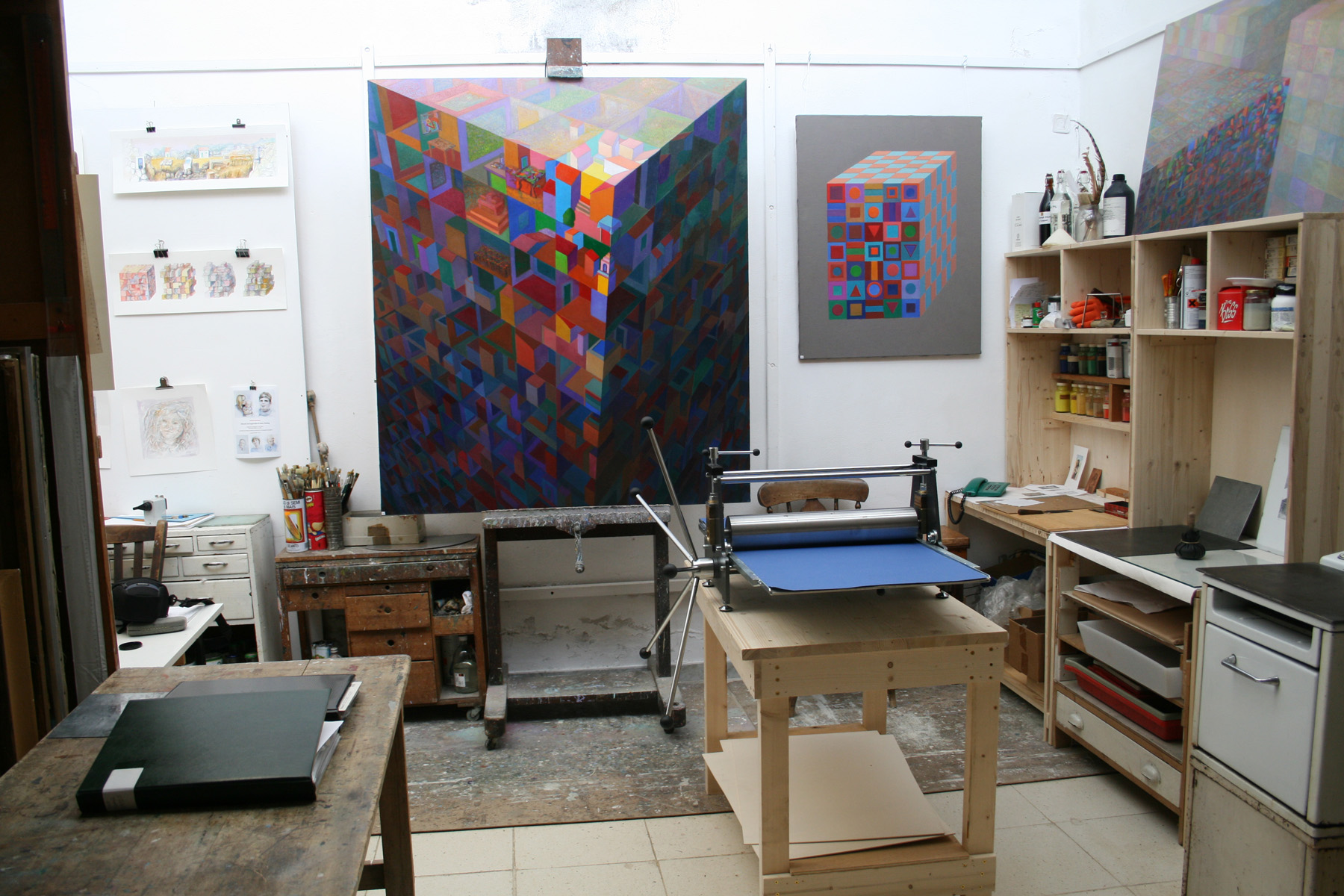 John's Sicilian studio
When I have a commission for an etching I have a different day. I have a friend assistant who helps me with an edition (he's the one with clean hands and I do the dirty work!). After lunch I have a short siesta (a habit I learned from my hosts in Spain). I work in the afternoon until 7pm.
John's Sicilian studio
When I have a commission for an etching I have a different day. I have a friend assistant who helps me with an edition (he's the one with clean hands and I do the dirty work!). After lunch I have a short siesta (a habit I learned from my hosts in Spain). I work in the afternoon until 7pm.
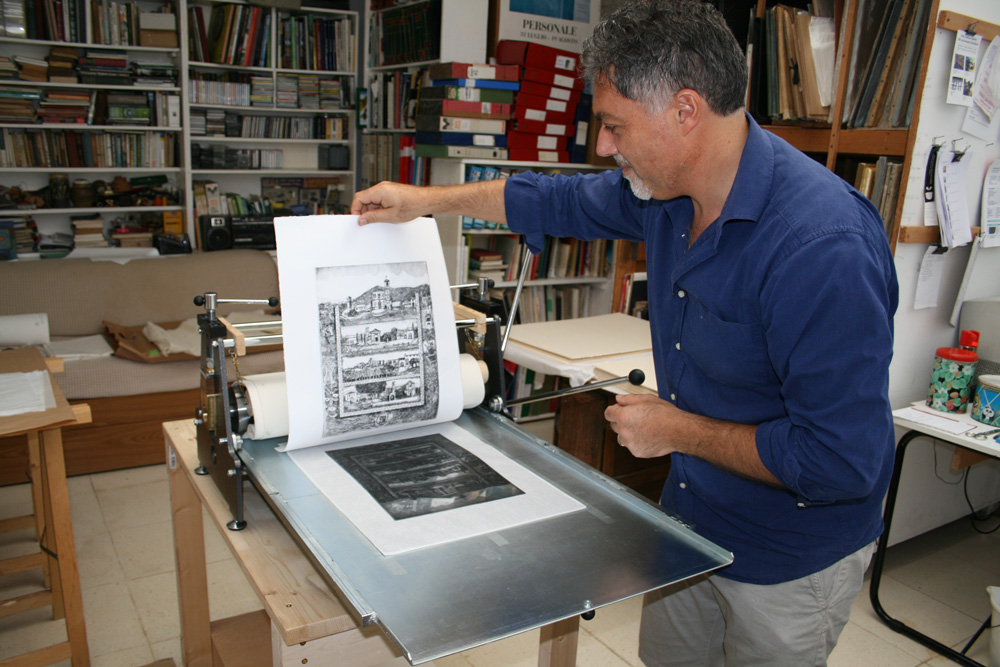 John's assistant Alessandro
I remember many years ago seeing a programme about Ronald Searle, the great cartoonist. He said he hated going out in the evenings because he would miss the fun. It was as though his hand was doing the drawing and he was the spectator.
Lawrence Art Supplies: What is your favourite colour and why?
That question is like asking a musician which is his favourite note. As I said earlier, it's all relative. In music you may have a favourite key or chords, in painting there may be various combinations of colour. I like to balance harmonies and contrasts, perhaps around a pair of complementary colours.
John's assistant Alessandro
I remember many years ago seeing a programme about Ronald Searle, the great cartoonist. He said he hated going out in the evenings because he would miss the fun. It was as though his hand was doing the drawing and he was the spectator.
Lawrence Art Supplies: What is your favourite colour and why?
That question is like asking a musician which is his favourite note. As I said earlier, it's all relative. In music you may have a favourite key or chords, in painting there may be various combinations of colour. I like to balance harmonies and contrasts, perhaps around a pair of complementary colours.
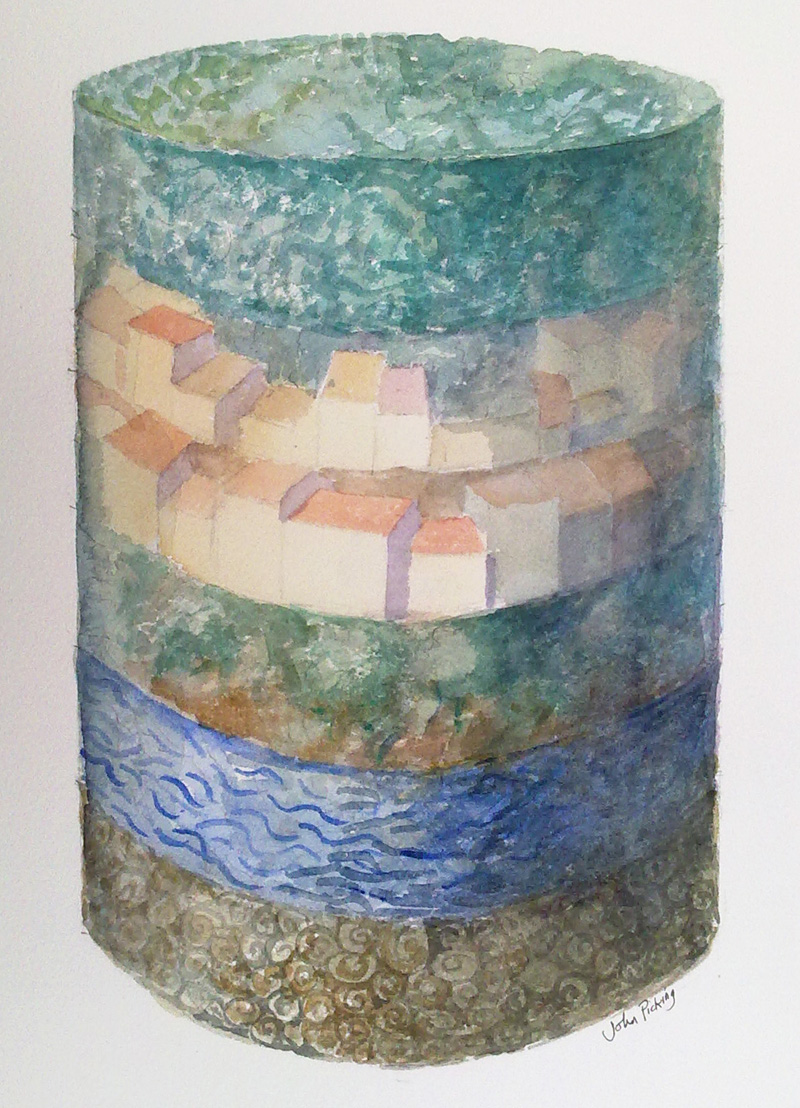 Cilindro Stratificato- watercolour
I use quite a lot of Indian yellow suggesting the dry cornfields of Sicily, but that makes me want its complementary violet in the shadows. I also need my catalyst, i.e. a colour outside the scheme which is like a joker forcing changes. After the changes he may be eliminated.
Lawrence Art Supplies: Who is/are your favourite artists and why?
I have always advised students to visit as many exhibitions as possible.
Everybody robs previous painters as they do their research for a personal project. I have robbed many: Poussin, Claude, Botticelli, Velasquez, Cezanne, Van Gogh, Klee, Picasso, Sutherland, Bryan Wynter (a friend at St Ives), Sam Francis, Rothko, Escher, etc.
Each day my enthusiasms change according to what I see in others' work. The reasons I like them may also be different each time. For example, in the National Gallery of Scotland there is a large Claude- “Landscape with River God” which I first saw in 1960! Every time I go to Edinburgh I drop in to see my old friend. It seems to change with the years and I have different reasons for appreciating it each time- I'm obviously the one who has changed.
John Picking
www.johnpicking.com
Cilindro Stratificato- watercolour
I use quite a lot of Indian yellow suggesting the dry cornfields of Sicily, but that makes me want its complementary violet in the shadows. I also need my catalyst, i.e. a colour outside the scheme which is like a joker forcing changes. After the changes he may be eliminated.
Lawrence Art Supplies: Who is/are your favourite artists and why?
I have always advised students to visit as many exhibitions as possible.
Everybody robs previous painters as they do their research for a personal project. I have robbed many: Poussin, Claude, Botticelli, Velasquez, Cezanne, Van Gogh, Klee, Picasso, Sutherland, Bryan Wynter (a friend at St Ives), Sam Francis, Rothko, Escher, etc.
Each day my enthusiasms change according to what I see in others' work. The reasons I like them may also be different each time. For example, in the National Gallery of Scotland there is a large Claude- “Landscape with River God” which I first saw in 1960! Every time I go to Edinburgh I drop in to see my old friend. It seems to change with the years and I have different reasons for appreciating it each time- I'm obviously the one who has changed.
John Picking
www.johnpicking.com
 John Picking in his studio in 2010.
Lawrence Art Supplies: Tell us a little bit about your artistic background and education. What inspired you to become an artist?
I did my first oil paintings at fourteen. On Sundays a friend and I would paint the landscape around Wigan. My efforts were terrible, but I was fired with enthusiasm and decided I wanted to study art.
I started at Wigan School of Art when I was sixteen but my drawing was the worst in the group. Anger with myself made me stay every evening for extra classes and after two years I won the Intermediate Course Prize. It was in that period that I first attended etching classes.
After the Diploma in Painting and Lithography, I went into the third year of the Painting School at Edinburgh College of Art. My dad sent me £2 a week and for six months I survived on egg and chips. Eventually I had to tell the Principal that I would have to leave the college, so I returned to my parents in Wigan. Shortly after I returned, I received a letter from Edinburgh College offering me an Andrew Grant bursary to complete my course. I was also given a Post-Diploma grant with my own studio in the college and this led to a further grant, a traveller for a year. I decided to paint in Spain.
Lawrence Art Supplies: Your more recent work predominantly deals with geometric shapes and space, who or what has influenced this particular interest?
John Picking in his studio in 2010.
Lawrence Art Supplies: Tell us a little bit about your artistic background and education. What inspired you to become an artist?
I did my first oil paintings at fourteen. On Sundays a friend and I would paint the landscape around Wigan. My efforts were terrible, but I was fired with enthusiasm and decided I wanted to study art.
I started at Wigan School of Art when I was sixteen but my drawing was the worst in the group. Anger with myself made me stay every evening for extra classes and after two years I won the Intermediate Course Prize. It was in that period that I first attended etching classes.
After the Diploma in Painting and Lithography, I went into the third year of the Painting School at Edinburgh College of Art. My dad sent me £2 a week and for six months I survived on egg and chips. Eventually I had to tell the Principal that I would have to leave the college, so I returned to my parents in Wigan. Shortly after I returned, I received a letter from Edinburgh College offering me an Andrew Grant bursary to complete my course. I was also given a Post-Diploma grant with my own studio in the college and this led to a further grant, a traveller for a year. I decided to paint in Spain.
Lawrence Art Supplies: Your more recent work predominantly deals with geometric shapes and space, who or what has influenced this particular interest? Macro e Micro II- oil painting
Amongst the ruins (from my past) there was a painting, a relief/collage/painting, the kind of thing that I did at Goldsmiths' College many years ago. A friend/collector asked me if that painting existed. I explained that exactly like that, it didn't. He commissioned me to paint it.
The return to a kind of painting I had abandoned years before gave me a strong sense of nostalgia.
In 1969, when I made my first trip to Italy my work had returned to be a kind of metaphysical landscape. Now I jump from one path of my work to the other. Why not? I speak English and Italian. Why can't I paint one minute in one language and the next in another? I could be called eclectic, but I get bored if I risk repeating the same technique all the time.
Macro e Micro II- oil painting
Amongst the ruins (from my past) there was a painting, a relief/collage/painting, the kind of thing that I did at Goldsmiths' College many years ago. A friend/collector asked me if that painting existed. I explained that exactly like that, it didn't. He commissioned me to paint it.
The return to a kind of painting I had abandoned years before gave me a strong sense of nostalgia.
In 1969, when I made my first trip to Italy my work had returned to be a kind of metaphysical landscape. Now I jump from one path of my work to the other. Why not? I speak English and Italian. Why can't I paint one minute in one language and the next in another? I could be called eclectic, but I get bored if I risk repeating the same technique all the time.
 When Picasso was a young man he moved through different periods. But if you notice by the dates on the work, from the late twenties onwards, he did a cubist painting in the morning and a neoclassical drawing in the afternoon.
Lawrence Art Supplies: You also paint figuratively, do the two interests relate to each other?
I have always been very keen on Rennaisance and neo-classical painters. I once read a book called The Hidden Geometry in Art. The best paintings for me have a powerful underlying structure, the thing Cezanne found in Poussin. It's a short step from Cezanne to Braque's first cubist paintings. More than thinking figuratively I think of forms and colours, even when I am doing a portrait.
When Picasso was a young man he moved through different periods. But if you notice by the dates on the work, from the late twenties onwards, he did a cubist painting in the morning and a neoclassical drawing in the afternoon.
Lawrence Art Supplies: You also paint figuratively, do the two interests relate to each other?
I have always been very keen on Rennaisance and neo-classical painters. I once read a book called The Hidden Geometry in Art. The best paintings for me have a powerful underlying structure, the thing Cezanne found in Poussin. It's a short step from Cezanne to Braque's first cubist paintings. More than thinking figuratively I think of forms and colours, even when I am doing a portrait.
 Lawrence Art Supplies: What is the most valuable piece of advice anyone has given you that you still use today?
There are two pieces that come to mind;
The first was at Edinburgh in a composition class. James Cumming, our teacher and well-known Scottish painter, sat down beside me. He mixed a middle tone of grey on my palette. Then he asked me to do two paintings: one where the grey was the darkest tone and the other where it was the lightest. I realised just how relative tone and colour are.
I say to my pupils, imagine a black and white chessboard on a window sill touched in part by a ray of sun. The white squares in the shade can be darker than the black squares in the sun!
The other advice was also whilst I was a student at Edinburgh. They gave me a small traveller to visit London but as I often went there I proposed something different; I was keen on Palmer and Sutherland and decided to investigate their landscape sources, Shoreham in Kent and Pembrokeshire in Wales respectively.
I wrote to Sutherland asking him where precisely he found those motifs. He very kindly invited me to his Trotiscliffe studio saying if I visited him while I was in Kent, he would mark his sources on a map. I took a folio of my drawings and etchings to show him and he encouraged me to follow my personal researches even when my teachers wanted something more academic.
Lawrence Art Supplies: You live in Italy, would you say your environment heavily influences your work?
Yes, it's to do with the light amongst other things. One of my early venues for a few months painting was Cornwall, where I met other painters at St Ives on the same quest. Later I discovered the Mediterranean, first Spain and then Italy. The terraced hillsides first built by the Arabs in Spain and Sicily gave a geometric structure to the landscape which appealed to me.
Lawrence Art Supplies: What is the most valuable piece of advice anyone has given you that you still use today?
There are two pieces that come to mind;
The first was at Edinburgh in a composition class. James Cumming, our teacher and well-known Scottish painter, sat down beside me. He mixed a middle tone of grey on my palette. Then he asked me to do two paintings: one where the grey was the darkest tone and the other where it was the lightest. I realised just how relative tone and colour are.
I say to my pupils, imagine a black and white chessboard on a window sill touched in part by a ray of sun. The white squares in the shade can be darker than the black squares in the sun!
The other advice was also whilst I was a student at Edinburgh. They gave me a small traveller to visit London but as I often went there I proposed something different; I was keen on Palmer and Sutherland and decided to investigate their landscape sources, Shoreham in Kent and Pembrokeshire in Wales respectively.
I wrote to Sutherland asking him where precisely he found those motifs. He very kindly invited me to his Trotiscliffe studio saying if I visited him while I was in Kent, he would mark his sources on a map. I took a folio of my drawings and etchings to show him and he encouraged me to follow my personal researches even when my teachers wanted something more academic.
Lawrence Art Supplies: You live in Italy, would you say your environment heavily influences your work?
Yes, it's to do with the light amongst other things. One of my early venues for a few months painting was Cornwall, where I met other painters at St Ives on the same quest. Later I discovered the Mediterranean, first Spain and then Italy. The terraced hillsides first built by the Arabs in Spain and Sicily gave a geometric structure to the landscape which appealed to me.
 Iso Piazza- oil on panel
At Goldsmiths' our teacher Anton Ehrenzweig proposed a project Organic v. Geometric, dividing the world of forms into two categories. This apposition of the two elements helped me appreciate those classical paintings and the various elements in a landscape. The combination of vines, olives and fig trees, for example, with the terraced landscape, has always been in the background of my work.
Lawrence Art Supplies: How do you approach a blank canvas, do you see in your mind how the finished painting should look?
There never seems to be a blank canvas. Your question brings to mind that film of Mr Bean who strokes his chin before a blank canvas wondering what to paint! Most of my ideas originate from drawings. During the day at the studio I work on a group of oils, in the evening I do scribbles of ideas, studies and watercolours. There is probably a theme running through them.
When I finish a group of oils I take the drawings to the studio, there may be fifty or more. I spread them out on the floor and choose between ten and fifteen and I attach a PostIt label on these allocating a size of canvas.
I often start with acrylics on a coloured ground for the first sitting. I probably start four or five in a day. I like to establish the linear structure of the painting but I can't say what the colour will be like in the end. That's a matter of changing and balancing as I go along. As I develop the works in oils the pace slows down and I may work on one canvas for a whole day or more before moving to the next. Having a group has technical advantages; I can leave time to dry between painting layers by moving on to the next which has been drying for a week or more. After about two months or so, I finish the cycle.
I never wait for inspiration; ideas arrive at odd moments, like when I'm at the supermarket. When I get home I do one of my scribbles.
Lawrence Art Supplies: What does your typical day in the studio entail?
I go to the studio at about 6am and answer e-mails and make notes on the day's work etc. Usually by 7 I'm at work on my canvases. Lately, I have been doing more commissioned art work and less for dealers, this means I may work longer on one thing.
Iso Piazza- oil on panel
At Goldsmiths' our teacher Anton Ehrenzweig proposed a project Organic v. Geometric, dividing the world of forms into two categories. This apposition of the two elements helped me appreciate those classical paintings and the various elements in a landscape. The combination of vines, olives and fig trees, for example, with the terraced landscape, has always been in the background of my work.
Lawrence Art Supplies: How do you approach a blank canvas, do you see in your mind how the finished painting should look?
There never seems to be a blank canvas. Your question brings to mind that film of Mr Bean who strokes his chin before a blank canvas wondering what to paint! Most of my ideas originate from drawings. During the day at the studio I work on a group of oils, in the evening I do scribbles of ideas, studies and watercolours. There is probably a theme running through them.
When I finish a group of oils I take the drawings to the studio, there may be fifty or more. I spread them out on the floor and choose between ten and fifteen and I attach a PostIt label on these allocating a size of canvas.
I often start with acrylics on a coloured ground for the first sitting. I probably start four or five in a day. I like to establish the linear structure of the painting but I can't say what the colour will be like in the end. That's a matter of changing and balancing as I go along. As I develop the works in oils the pace slows down and I may work on one canvas for a whole day or more before moving to the next. Having a group has technical advantages; I can leave time to dry between painting layers by moving on to the next which has been drying for a week or more. After about two months or so, I finish the cycle.
I never wait for inspiration; ideas arrive at odd moments, like when I'm at the supermarket. When I get home I do one of my scribbles.
Lawrence Art Supplies: What does your typical day in the studio entail?
I go to the studio at about 6am and answer e-mails and make notes on the day's work etc. Usually by 7 I'm at work on my canvases. Lately, I have been doing more commissioned art work and less for dealers, this means I may work longer on one thing.
 John's Sicilian studio
When I have a commission for an etching I have a different day. I have a friend assistant who helps me with an edition (he's the one with clean hands and I do the dirty work!). After lunch I have a short siesta (a habit I learned from my hosts in Spain). I work in the afternoon until 7pm.
John's Sicilian studio
When I have a commission for an etching I have a different day. I have a friend assistant who helps me with an edition (he's the one with clean hands and I do the dirty work!). After lunch I have a short siesta (a habit I learned from my hosts in Spain). I work in the afternoon until 7pm.
 John's assistant Alessandro
I remember many years ago seeing a programme about Ronald Searle, the great cartoonist. He said he hated going out in the evenings because he would miss the fun. It was as though his hand was doing the drawing and he was the spectator.
Lawrence Art Supplies: What is your favourite colour and why?
That question is like asking a musician which is his favourite note. As I said earlier, it's all relative. In music you may have a favourite key or chords, in painting there may be various combinations of colour. I like to balance harmonies and contrasts, perhaps around a pair of complementary colours.
John's assistant Alessandro
I remember many years ago seeing a programme about Ronald Searle, the great cartoonist. He said he hated going out in the evenings because he would miss the fun. It was as though his hand was doing the drawing and he was the spectator.
Lawrence Art Supplies: What is your favourite colour and why?
That question is like asking a musician which is his favourite note. As I said earlier, it's all relative. In music you may have a favourite key or chords, in painting there may be various combinations of colour. I like to balance harmonies and contrasts, perhaps around a pair of complementary colours.
 Cilindro Stratificato- watercolour
I use quite a lot of Indian yellow suggesting the dry cornfields of Sicily, but that makes me want its complementary violet in the shadows. I also need my catalyst, i.e. a colour outside the scheme which is like a joker forcing changes. After the changes he may be eliminated.
Lawrence Art Supplies: Who is/are your favourite artists and why?
I have always advised students to visit as many exhibitions as possible.
Everybody robs previous painters as they do their research for a personal project. I have robbed many: Poussin, Claude, Botticelli, Velasquez, Cezanne, Van Gogh, Klee, Picasso, Sutherland, Bryan Wynter (a friend at St Ives), Sam Francis, Rothko, Escher, etc.
Each day my enthusiasms change according to what I see in others' work. The reasons I like them may also be different each time. For example, in the National Gallery of Scotland there is a large Claude- “Landscape with River God” which I first saw in 1960! Every time I go to Edinburgh I drop in to see my old friend. It seems to change with the years and I have different reasons for appreciating it each time- I'm obviously the one who has changed.
John Picking
www.johnpicking.com
Cilindro Stratificato- watercolour
I use quite a lot of Indian yellow suggesting the dry cornfields of Sicily, but that makes me want its complementary violet in the shadows. I also need my catalyst, i.e. a colour outside the scheme which is like a joker forcing changes. After the changes he may be eliminated.
Lawrence Art Supplies: Who is/are your favourite artists and why?
I have always advised students to visit as many exhibitions as possible.
Everybody robs previous painters as they do their research for a personal project. I have robbed many: Poussin, Claude, Botticelli, Velasquez, Cezanne, Van Gogh, Klee, Picasso, Sutherland, Bryan Wynter (a friend at St Ives), Sam Francis, Rothko, Escher, etc.
Each day my enthusiasms change according to what I see in others' work. The reasons I like them may also be different each time. For example, in the National Gallery of Scotland there is a large Claude- “Landscape with River God” which I first saw in 1960! Every time I go to Edinburgh I drop in to see my old friend. It seems to change with the years and I have different reasons for appreciating it each time- I'm obviously the one who has changed.
John Picking
www.johnpicking.com 





